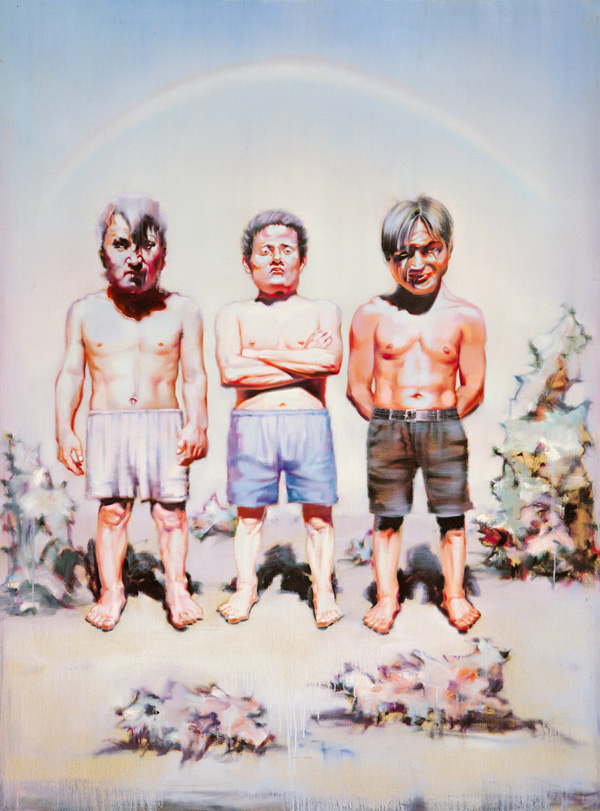EXHIBITED:
Myth, Beijing Art Museum, Beijing, 2001
Myth, Aura Gallery, Shanghai, 2002
Myth, Today Art Museum, Beijing, 2006
ILLUSTRATED:
Yin Zhaoyang - Mythology, Art-W.com Center, Beijing, 2001, color illustrated, pp. 72-73
Artists of Today - Yin Zhaoyang, Hebei Education Press, Sjzchina, 2005, color illustrated, p. 13 & p. 24
Mythology - Yin Zhaoyang, Sichuan Art Publishing House, Chengdu, 2006, color illustrated, pp. 44-45
Catalogue Note:
Yin Zhaoyang was born in Nah Yang City, Henan province in 1970, graduated from Central Institute of Fine Arts in Beijing with Engraving Major in 1966. He now resides in Beijing. In 1999 he participated in "Sharp New Sights" exhibition at Beijing International Art Museum, in 2001 he had a solo exhibition "Mythology" at the Beijing Capital Art Museum, he also participated "The first Chengdu Biennale" at the Chengdu Modern Art Museum in the same year, in 2002 he participated in "The Youth Cruelty Painting" exhibition organized by the Atm Art Warehouse in Shanghai, and Yanhuang Art Museum in Beijing. In the same year he also had a solo exhibition "Mythology" in Aura Gallery, Shanghai, a group exhibition "Image about Images" in Shenzhen Art Museum in 2003, "Chinese Art Triennale" in Nanjing Museum in 2004, and a solo exhibition "Mythology" organized by Beijing Museum and Shanghai Aura Gallery in 2006.
The generation born in 1970's China has been considered as the one that is most deeply attached to Heroism. The dramatic circumstances towards the end of Chinese Revolution have become the unforgettable mark of their lives. However, since this generation never directly witnessed this passionate era, it created the possibility for artists to detach from passing any political judgments. The historical events became incredibly attractive to the artists. Even though they could only piece together the romantic memories and sensations of the Cultural Revolution in their minds. Though gone with the revolution and youth, the sincere worship towards heroes and idols has been rooted deeply in their conscious. The 70's generation all experienced a kind of sadness. They are adults with elements of adolescent ideology. The lack of idol after 1960's made it into a lonesome generation.
Yin Zhaoyang is the emblem of artists from this 70's generation. There is no typical spoiled urban youth figure in his work. The artist doesn't over embellish common themes like Tiananmen, Mao Zedong or revolutionists in his works. All the emotions came from Yin Zhaoyang's reminiscing of history and the fleeting youth. The absolute optimism as an artist gave his work a realistic sense of the long gone heroism. Like many artists of this generation, Yin Zhaoyang was trained classically. Realism naturally became his creative method of choice. The difference in Yin Zhaoyang's work is that everything about revolution has become transcendental and highly idealized. In the "Mythology" series, Yin Zhaoyang uses the myth of "Sisyphus" in order to further elaborates on the evolution from individual idealism and historical responsibility to a highly possessive sense towards nobleness and therefore created an irrepressible personal energy.
This particular piece "Stone" was created in 2000 is part of Yin Zhaoyang's "Mythology" series. This description is originated from his discovery of a rock on the way home. "I quietly stood by the sidewalk, silent, pale, and stiff. Suddenly a sense of compassion came to me. For about two minutes I stood opposite the rock. Then I went home feeling quite heavy myself." The image consists of three boys packed up and "ready to go". The rainbow behind them indicates a sense of hope. The environment appears to have an aura of relaxation. The different arm positions and facial expressions of the boys illustrate a sense of uncertainty towards future. One of each three faces shows tenderness, austerity and confidence. The nuances created motions for the image. These characters already began to gear away from the typical early 1990's rebellious youth ideal. It transformed the artistic notion into an ethological sense of self-expression. These characters all represent part of the artist's own persona. He has been shaken by the gloriously tragic force of the hero and therefore instinctively developed a temperament of heroism of his own.
